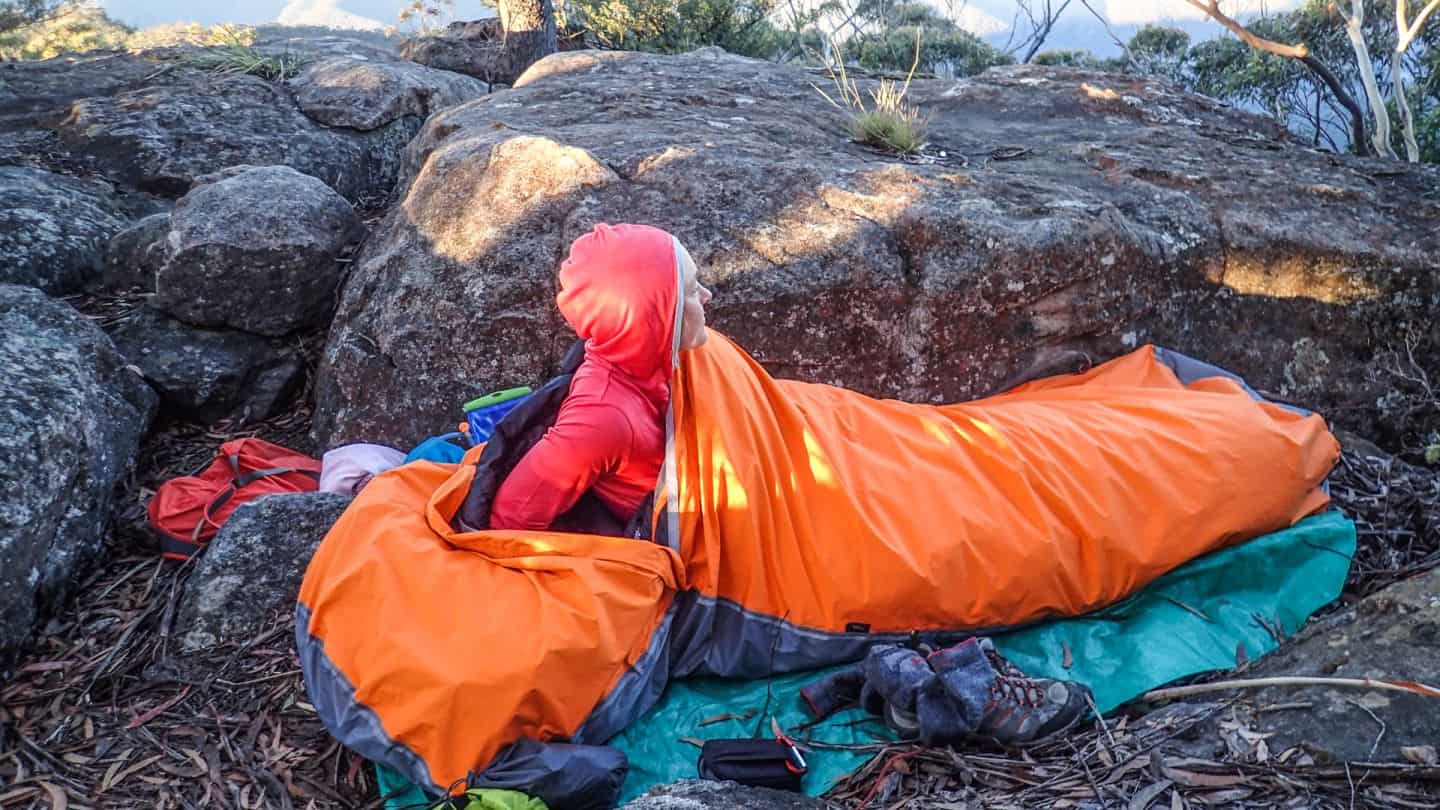It’s inevitable, when looking at safety devices for outdoor adventures to compare the various options available, of which there are several on the market. Whilst these days, people are more familiar with a device like a SPOT or Garmin InReach, the Yellowbrick satellite tracking device has been on the market for many years and is more commonly associated with ocean racing.
When I first heard about this product a few years ago, I couldn’t help but think that perhaps the marketing folks hadn’t consulted with the outdoors community, specifically the lightweight hiking niche. I can’t think of any bushwalker or hiker who would want to carry any device called a brick, yellow or otherwise.
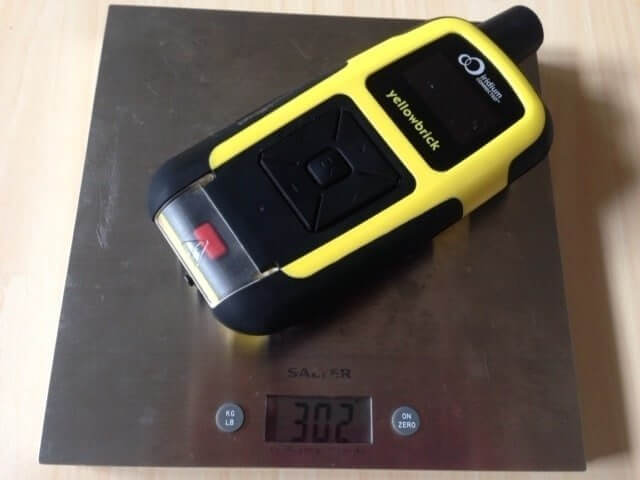
Therefore, I was pleasantly surprised when I finally held it in my hand to find it weighed 302 gms. It is one of those things that looks heavier than it really is, however this is compared to my RescueMe PLB Personal Locator Beacon which comes in at a tiny 116gms.
A really important thing to point out from the beginning is that the Yellowbrick isn’t a PLB.
What’s the difference between the Yellowbrick and a PLB?
A Personal Locator Beacon or PLB is a one-way communication device, which sends an emergency signal via satellite (with location co-ordinates) to the organisation responsible for managing these messages in each country. In Australia, that organisation is AMSA. With a PLB there is no way of sending specific messages – it is simply a distress beacon. This means that you can’t change the message to be “I’m OK, just running 3 hrs late due to broken shoe-lace“, versus “Brad has fallen 8m, unconscious, send help ASAP.”
The difference with the Yellowbrick is that it is a two-way satellite messaging device, which tags each of your transmissions with your lat long position. Imagine being able to send emails or SMS messages whenever mobile coverage is unavailable, from anywhere in the world via the Iridium Network.
Differentiating between these two types of devices is key to deciding which one best suits your particular remote area needs.
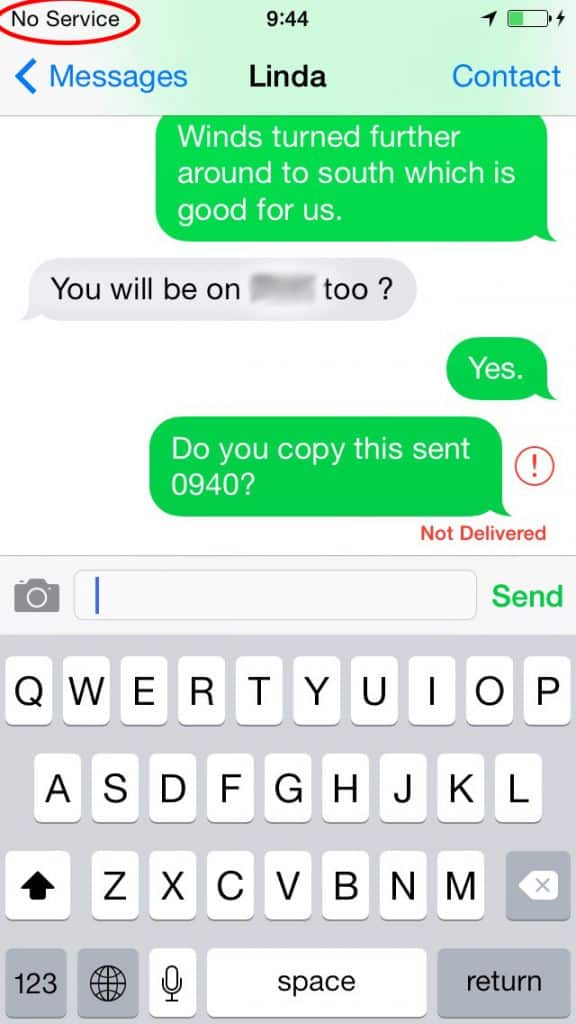
Now, speaking of anywhere in the world, with perfect timing I found myself heading for a very remote part of Fiji for work. Although not my classic wilderness location, it was the perfect place to put the Yellowbrick through it’s paces.

Who receives your messages?
The first thing that I learnt about the Yellowbrick is that you need to set it up through logging in online first. I would definitely recommend giving yourself a few days to get familiar with the device and the setup before heading out into the wilderness. It’s here that you add in the mobile numbers and email addresses into the Contacts Tab for the people you want to receive your messages. This is another important difference between the Yellowbrick and a PLB. With the Yellowbrick it will only send messages to those people you nominate. ie. it doesn’t go to any Emergency Services. For the test, I added two people, a family member back in Australia and also my colleague who was working at our base in Fiji whilst I was out on a deserted island (yes, I know, sounds terrible).
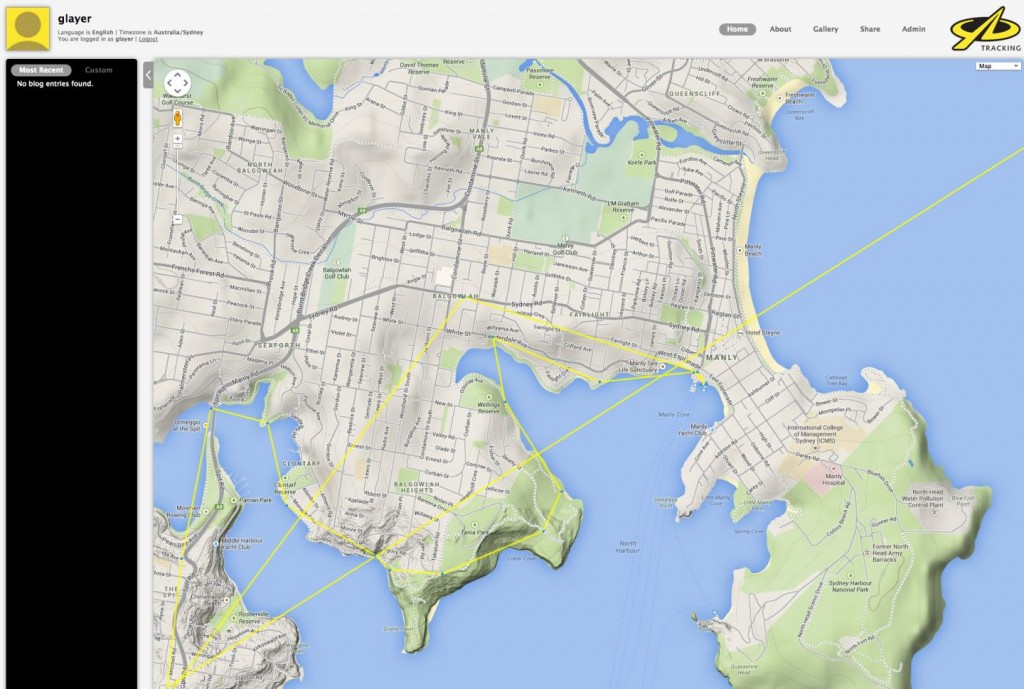
One thing I really liked about the device is the public side of this website. It meant that I could give the link to my colleagues, friends, family, etc and they could track where I was at anytime through a Google Maps interface. From a safety perspective, this was good as it meant that the time I was travelling between the islands which involved a 45 min helicopter trip over water and then another 45 min trip in open waters in a small outboard runabout, I was always visible.
These pings happen without you needing to do anything and I had the device sitting inside my backpack in the top pocket with no problems.
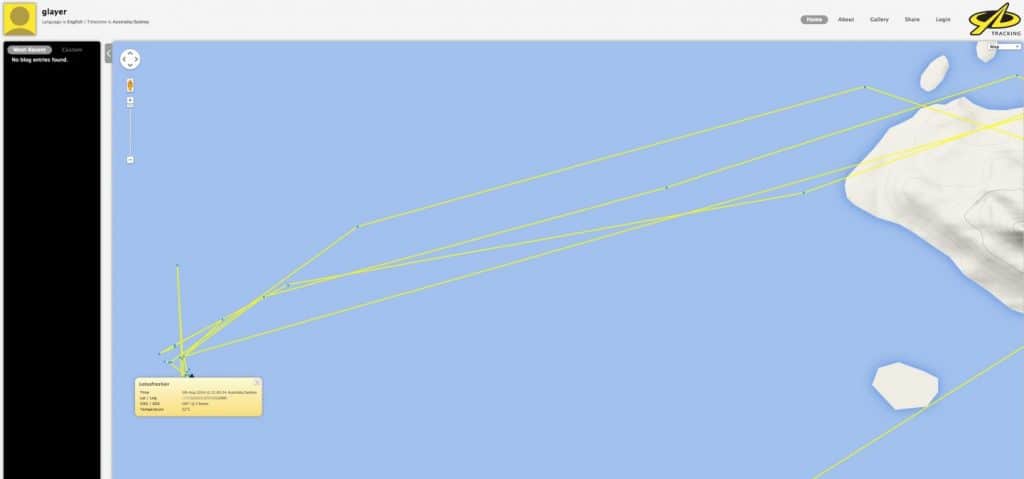
The frequency of the pings (that’s Caro speak for Transmission Frequency) that the device automatically sends can be set from either the device or through the online login – ranging from 1 min to 720 mins. Obviously, the more often the device punches out a ping, the more battery life you chew through. When I was moving quickly over open water in Fiji, I set it to send every 5-10 mins. However, if I was hiking, I’d be more likely to set it to send every 30 mins, where at a fast walk, I’m only ever going to be no more than 3kms from my last ping. According to the website, if it sends a ping every 15mins non-stop, the battery life will last for 19 days. If you send additional transmissions (like SMS, FreeText or emails) it will reduce this battery life.
Interestingly, my deserted island was so remote that even Google Maps didn’t know that it exists! The blue dots indicate the automatic pings and show such info as:
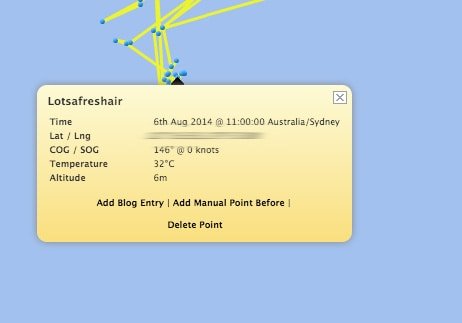
Sending Messages
So apart from the standard ping tranmissions that simply tells our nominated people where you are, the good thing about two-way devices is that you can tell them a whole lot more. There are a several different ways to do it with the Yellowbrick.
Firstly, it has a FreeText SMS style message that you can send. It goes out to the people that you’ve previously setup in your online Contacts tab with no ability to select particular recipients. Using an onscreen keyboard and tapping through your arrow buttons you can send an SMS up to 5000+ characters (50 characters costs 1 credit). Obviously a bit tedious and slow, but a good cheap way of sending a short message, however, the upside is that you only need one device and if your smartphone has run out of battery, you can still use this. Along with FreeText, you can also quickly send set-messages that come programmed into the device such as, “OK”, “SEND HELP”, etc. Hmmm, I was mighty surprised to find that it didn’t have “SEND COLD BEER, GOOD COFFEE AND A COOL BREEZE.”… I really could have done with that one! 🙂
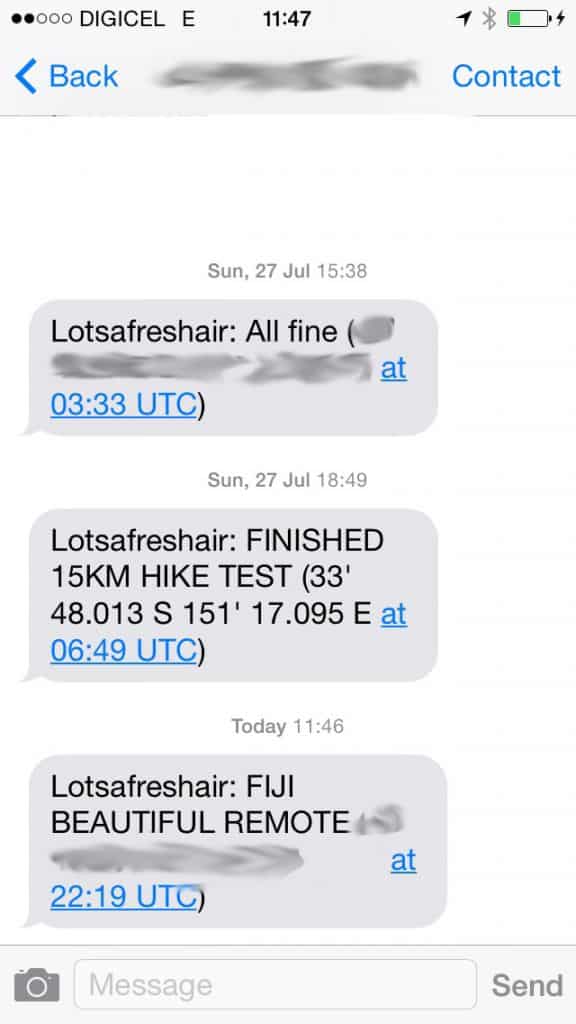
The other inbuilt message that the YB can send is the emergency message. Again, setting it apart from a PLB, this only goes to the people you nominate online and not direct to emergency services. If something is really wrong, you’ve got to be hoping that amongst the people you nominate, someone is listening, has their phone charged up and is watching your back. This is one of the real sticking points in only carrying a device like a Yellowbrick and not a PLB also.

The sleeker way of sending messages though, is definitely through another device such as a smartphone or tablet. You simply need to download the free app (iOs, Android) and pair it to the device via BlueTooth. One thing I would say about this process is that holding the two devices in your hands at once (whilst trying to keep everything up off the sandy beach and away from the crabs and seabirds), was a bit of a juggling act – even though the YB is waterproof and shock resistant. Once paired, I was able to stick the YB back into my backpack and send messages (both emails and SMS) just from the App on the iPhone. However, the device did ‘unpair’ itself after 15 mins, which I found a bit annoying, but this idle time can be changed to manage your battery life of both your smart-device and the Yellowbrick.

Again, the joy of two-way communication, meant that my colleagues were able to respond and ask me questions.
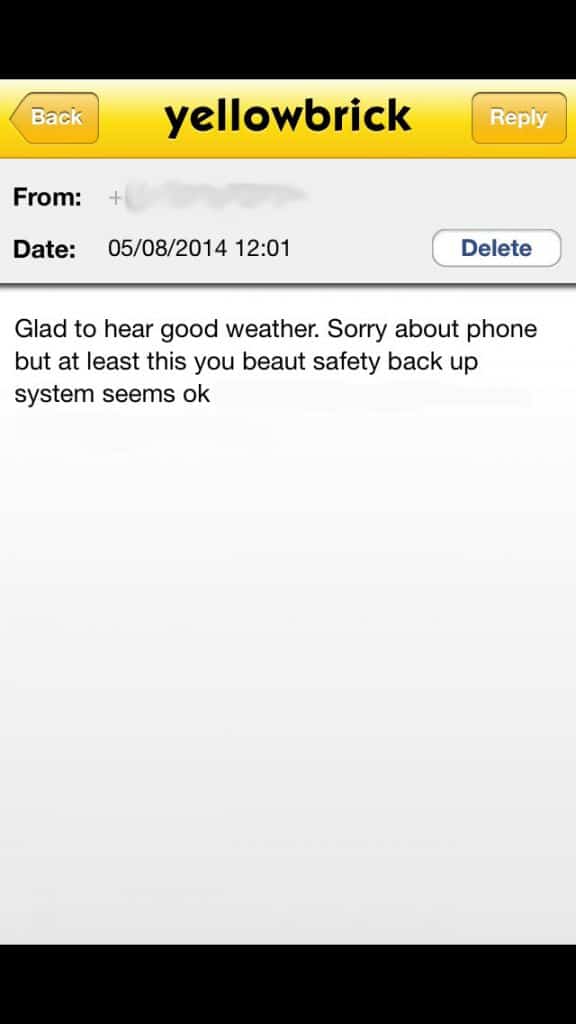
Cost of Yellowbrick
Unlike a PLB, a two-way device like the YB has two ongoing costs that you service through the same online login. These are costs for access and use of the Iridium Satellite network, not set by the device manufacturer. The good thing with YB is that this is not a contract – you don’t need to buy in for say, 12 months if you’re only going to be out adventuring for 2. The other cost is purchasing credits. For example a position report “ping” is 1 credit. There are different bundles and prices, but to give you an idea 200 credits is $30AUD – oh and these don’t expire (as at 2014).
Things that made me go, huh?
- Don’t go looking for an on/off switch or icon… it’s called Deactivate. Kind of like a Dalek, but not.
- Initial setup online and pairing with devices is best done with an instruction manual (it’s a downloadable PDF).
Who is it good for?
I do think there are some good uses for the Yellowbrick. In particular, I think that expedition trips, where regular reporting is necessary or for keeping sponsors and supporters in the loop. This usage has been proven many times in the past as seen in their own blog. The other place where I see that it is a good addition to a backpack is for solo hikers, especially those who go off-track or further afield, where you feel a sat-phone (which works out more expensive) is over-doing it, but want to keep family and friends in the loop. The key is to remember it’s not a PLB, so if you should be carrying one of those, you should do so and think of a Yellowbrick as an additional (and different) form of communication.
Yellowbrick at a glance
- Product Yellowbrick v3
- Weight 302g (10.65 oz)
- Initial Price From $619* AUD
- Ongoing Costs
- Height 144 mm (plus antenna)
- Width 76 mm
- Depth 36 mm
- Major Competitors – Check out my comparison article on SPOT vs PLB vs InReach
- *Prices correct as at 16 Sept 2014.
What is a Lotsafreshair Roadtest?
I’m not the type of person to pull apart the tech specs and go into minute detail over nerdy/boffin speak. I approach all products from a very practical, user point of view and imagine myself receiving the product for the first time. Because I’m not a product expert, just an experienced wilderness hiker, you’ll get my hands-on experience and feelings about products.



